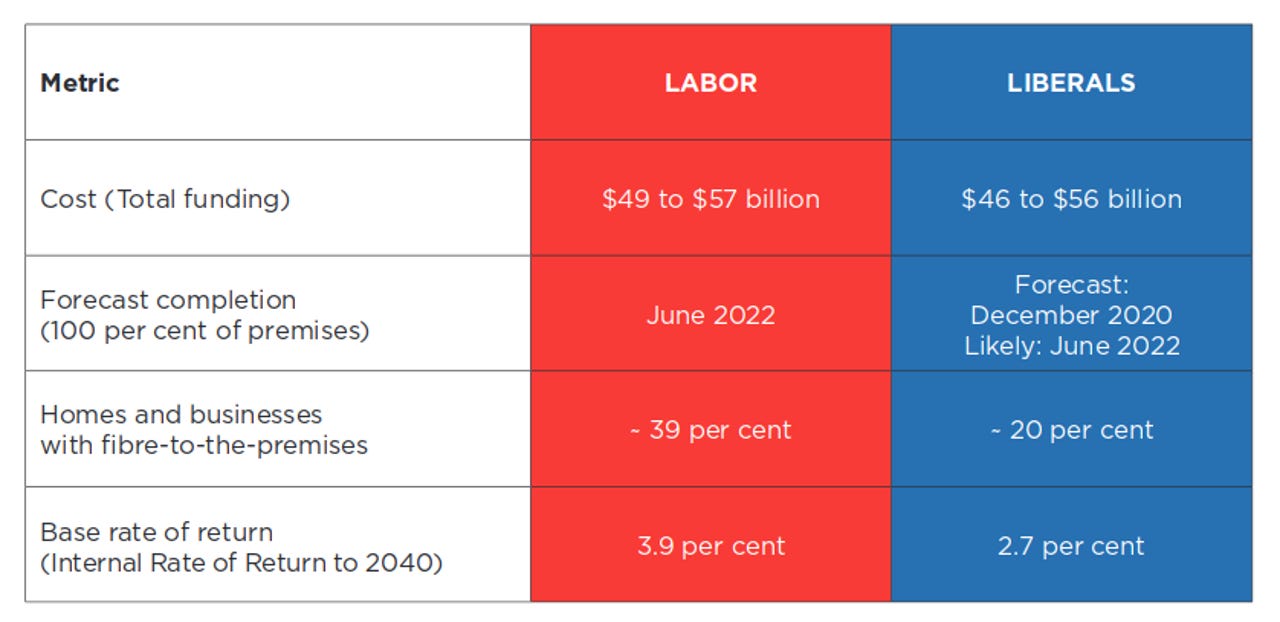Labor pledges to end FttN for up to 2 million FttP NBN connections

Labor announced its revised plans for the National Broadband Network on Monday morning, which will see a Shorten-led government phase out fibre to the node (FttN) after current contracts obligations are met, and attempt to return as many as 2 million premises to fibre to the premise (FttP) connections.
The addition of these new FttP areas would see FttP make up approximately 39 percent of the network, almost double the number slated under the Coalition.

Under Labor's plan, the total funding needed by the company responsible for deploying the NBN across Australia would increase by AU$1-3 billion dollars, and would see the network completed in 2022. The Opposition said under its plan, the rate of return on the network would jump to 3.9 percent compared to 2.7 under NBN's current arrangements.
The Opposition said it would retain the HFC network that NBN is set to acquire from Telstra, while it would "explore" the option of using fibre to the distribution point.
"Under Labor, the rollout of HFC (PayTV) will continue, recognising the contracts in place, the substantial capital expenditure already sunk, and the constraints placed on future governments by Mr Turnbull in the revised Definitive Agreements," Labor said in its NBN policy (PDF).
Total funding for the NBN would be capped at AU$57 billion, with the party stating this cap will have prioirity over extending FttP to more homes.
"Labor will spend exactly the same amount of public funding on the NBN as the Liberals. There will be no impact on the budget from this announcement," Opposition Leader Bill Shorten said in a statement. "The public equity contribution will be the same regardless of who wins the election."
"Fast broadband creates jobs. But you can't have an innovation boom while you are still buffering."
A Shorten government would commission Infrastructure Australia within its first term to look at options to transition FttN users to FttP.
Although the NBN, in its current Coalition-decreed multi-technology mix configuration, is scheduled to be completed in 2020, Labor said it is more likely to be finished in 2022, and under its plan would see NBN exceed its peak of 175,000 new premises connected to FttP that it posted in June 2015.
"Peak fibre to the premises ready for service build numbers in Labor's plan are prudent and achievable," Labor's policy said. "The transition back to fibre to the premises will take place in a manner that is manageable for NBN Co's construction partners and does not cause workforce demobilisation. "
"Peak fibre to the premises volumes are expected to be slightly higher, recognising that the June 2015 build numbers were reached at a time when NBN Co was focussed on commencing the HFC and FttN builds rather than ramping up the fibre build."
The Coalition's multi-technology mix NBN model aims to cover 20 percent of the Australian population with FttP; 38 percent with FttN, fibre to the building , or fibre to the distribution point; 34 percent with HFC; 5 percent with fixed wireless; and 3 percent with satellite services.
Echoing sentiments said last year by Shadow Communications Minister Jason Clare, Labor conceded it could not rip out existing nodes, or stop work on FttN without causing further issues and wasting money.
"I can't fix the mess this government has made with the flick of a switch or pull out every node or stop all the work NBN is currently doing without potentially causing more problems and wasting a lot of sunk investment," Clare said in October.
"If anyone thinks I can just click my fingers the day after the election and we can go back to the way it was they will be disappointed."
At the end of February, NBN said it had 23,232 FttN services activated. In December last year, almost a full 14 months since NBN announced construction work would begin on FttN, Minister for Communications Mitch Fifield proudly announced that in 51 days, 1,000 customers had signed up to FttN services.
Labor said it estimates by June 30 there will 3.5 million premises covered by design contracts to receive FttN broadband.
"A proportion of these design contracts will be repurposed or renegotiated as appropriate to achieve identified policy outcomes," it said.
During the election campaign, the NBN found itself in the spotlight following Australian Federal Police (AFP) raids on the office of former Communications Minister Senator Stephen Conroy, and the home of a Labor staffer.
The AFP is currently investigating the leaking of confidential documents out of the company responsible for deploying the NBN around Australia, however the documents seized in the raids are currently with the Senate clerk, and await the next sitting of the upper house to determine whether Labor's claim of parliamentary privilege on the documents applies. That sitting will occur after the July 2 election.
A recent poll conducted by Metapoll exclusively for ZDNet showed the NBN was named as the most important issue for 6 percent of voters.
An earlier Metapoll survey showed that the NBN enjoyed support from 86 percent of respondents, with only 15 percent against the project once those who responded with "don't know" were excluded.